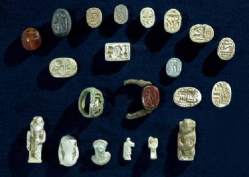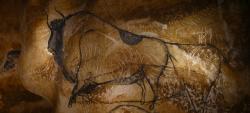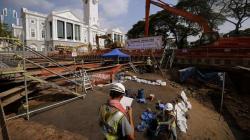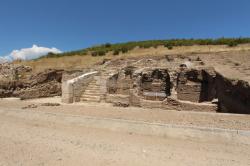INSTITUT SUPERIEUR D'ANTHROPOLOGIE
INSTITUTE OF ANTHROPOLOGY
ONLINE COURSES / COURS A DISTANCE
FALL TERM : OCTOBER 2015
REGISTER NOW
INDONESIE - Ohoidertaun - Ancient rock paintings have been discovered in the Ohoidertaun village of Kei islands. These include at least 400 images, among others of humans, hand prints, trees, and boats, the head of Ambons archaeology office Muh. Husni said on Friday. "Up to now, the Mesolithic discovery was still the most image-contained rock panting that had been found in the Maluku province," he added. According to him, the Ohoidertaun rock paintings have not been studied further, including their age. "We do not know the age yet. It needs in-depth research. However, according to the number of motive images, we can conclude that the culture at the time was well developed," Husni said. So far there are three rock painting sites that have been studied by the archaeology office, namely in Wamkana (South Buru district), Sawai (Central Maluku district), and the Ohoidertaun (Kei islands). An archaeologist from Ambons archaeology office, Wuri Handoko, said the rock paintings found at the three sites are most likely related to each other, and could explain the human migration pattern in Maluku. "If we see the landscape, the rock paintings have been found in the coastal areas. It indicates there was a long distance traversed through these areas by the ancient humans," she said. A pre-historic expert from Ambons archaeology office, Marlon Ririmasse, said a research team had discovered ancient paintings in a cave where ancient humans lived, located on the Kobror Island of the Aru Island district. The difference is the motifs was not as good as the ones found in Wamkana, Sawai, and Ohoidertaun. Ancient paintings in Kobror are shaped geometrically like a man, tree, and a curve with scratch technique using ocher. The tree-shaped image is believed to be the tree of life that symbolizes faith in the Creator, Ririmasse said. "The paintings on Kobror Island are cave paintings, not rock paintings like the ones found in Wamkana, Sawai, and Ohoidertaun," he added.
http://www.antaranews.com/en/news/98668/ohoidertaun-rock-paintings-discovered-in-kei-islands
ISRAEL –  Lahav - Even after fleeing Egypt and the end of exile, the land of Pharaohs continued to influence Jews. Confirmation of this comes from new findings by Israeli archaeologists who found multiple evidence of this presence. Excavation work neat the kibbutz Lahav, in the southern part of the country, has brought to light findings from the late Bronze Age (about 1500 BC) and the Iron Age (1000 BC), or over 3,000 years ago: more than 300 basins of different kinds, including some that are still intact. And together were found vases and bronze jewelry, shells, majolica, unique yellow alabaster basins, seals and cosmetic vases. According to archaeologist Amir Ganor, director of the unit for the prevention of antiquity theft at the Israeli Antiquities Authority - quoted in a statement - ''among various findings discovered, many from the Jewish culture in the southern part of the country, we have found dozens of stone seals, some of them shaped like winged beetles, with engraved symbols and images typical of Egyptian culture that dominated in the country in the late Bronze Age. Some of the seals were modelled on semi-precious stones from Egypt and the Sinai peninsula''. For Daphna Ben-Tor, curator of Egyptian archaeology at the Museum of Israel - also quoted in the statement - ''most of the beetle-shaped seals found in the excavation were dated between the XV-XIV century before Christ. The names of kings were printed on some of the seals.
Lahav - Even after fleeing Egypt and the end of exile, the land of Pharaohs continued to influence Jews. Confirmation of this comes from new findings by Israeli archaeologists who found multiple evidence of this presence. Excavation work neat the kibbutz Lahav, in the southern part of the country, has brought to light findings from the late Bronze Age (about 1500 BC) and the Iron Age (1000 BC), or over 3,000 years ago: more than 300 basins of different kinds, including some that are still intact. And together were found vases and bronze jewelry, shells, majolica, unique yellow alabaster basins, seals and cosmetic vases. According to archaeologist Amir Ganor, director of the unit for the prevention of antiquity theft at the Israeli Antiquities Authority - quoted in a statement - ''among various findings discovered, many from the Jewish culture in the southern part of the country, we have found dozens of stone seals, some of them shaped like winged beetles, with engraved symbols and images typical of Egyptian culture that dominated in the country in the late Bronze Age. Some of the seals were modelled on semi-precious stones from Egypt and the Sinai peninsula''. For Daphna Ben-Tor, curator of Egyptian archaeology at the Museum of Israel - also quoted in the statement - ''most of the beetle-shaped seals found in the excavation were dated between the XV-XIV century before Christ. The names of kings were printed on some of the seals.
Among other things, a sphinx on the opposite side of the name of Pharaoh Thutmode who reigned between 1504-1450 before Christ was identified. Another seal shaped like a beetle bears the name f Amenhotep on the throne between 1386-1349 before Christ. Another beetle portrays Ptah, the main god of the city of Menfi''.
http://www.ansamed.info/ansamed/en/news/nations/egypt/2015/04/24/archaeology-israel-egyptian-findings-from-bronze-age_53eee116-c0ec-46d7-bc36-3c0cff2ab2db.html?idPhoto=1
FRANCE –  Grotte Chauvet - After the retreat of Neanderthals across the European continent, modern humans made their way to this cave and began to create the first known works of pictorial art: buffalos surging across the rock background, rhinoceroses doing battle, lions searching for mates and dark-maned horses cantering. Twenty years after these cave paintings were discovered near the Ardèche River in south-central France, they remain closed to the public for preservation’s sake. But on Saturday, a replica built nearby at a cost of $59 million will open, allowing the public to approximate the experience of the cave explorers who found the paintings. The rock art in the Chauvet cave, created 32,000 to 36,000 years ago, puts flesh and fur and character onto a world previously known largely through fossil remains. Although archaeologists have recorded the impulse to create art in markings on rock and carved beads as far back as 75,000 years ago, the workmanship in these cave paintings is of another order. The subject matter, the animal world, is familiar, creating a remarkable feeling of connection with the distant past. The paintings are among the world’s most celebrated prehistoric artworks, featured in Werner Herzog’s 2011 3-D movie, “Cave of Forgotten Dreams.”
Grotte Chauvet - After the retreat of Neanderthals across the European continent, modern humans made their way to this cave and began to create the first known works of pictorial art: buffalos surging across the rock background, rhinoceroses doing battle, lions searching for mates and dark-maned horses cantering. Twenty years after these cave paintings were discovered near the Ardèche River in south-central France, they remain closed to the public for preservation’s sake. But on Saturday, a replica built nearby at a cost of $59 million will open, allowing the public to approximate the experience of the cave explorers who found the paintings. The rock art in the Chauvet cave, created 32,000 to 36,000 years ago, puts flesh and fur and character onto a world previously known largely through fossil remains. Although archaeologists have recorded the impulse to create art in markings on rock and carved beads as far back as 75,000 years ago, the workmanship in these cave paintings is of another order. The subject matter, the animal world, is familiar, creating a remarkable feeling of connection with the distant past. The paintings are among the world’s most celebrated prehistoric artworks, featured in Werner Herzog’s 2011 3-D movie, “Cave of Forgotten Dreams.”
http://www.nytimes.com/2015/04/25/arts/design/the-chauvet-caves-hyperreal-wonders-replicated.html?
VIDEO = https://fr.news.yahoo.com/r%C3%A9plique-grotte-chauvet-%C3%A9merveille-visiteurs-150427465.html
SINGAPOUR –  - Archaeological discoveries keep confirming that there was a thriving community here long before Stamford Raffles "created" Singapore in the 19th century. The latest evidence suggests that Temasek, or ancient Singapore, could have had an established government with a head ruler or chieftain way back in the late 14th century. In unearthing this evidence during a dig at Empress Place, archaeologists have shed light on gaps in knowledge of the past. Singapore's history was supposed to have begun with the providential role of colonials who made it a functional landing post. The evidence suggests otherwise. In digging it up, the archaeological team has provided additional proof of Singapore's international provenance as well. It has discovered Chinese imperial-grade ceramics produced between 1375 and 1425. These had been bestowed by the Ming Dynasty emperor Hongwu on overseas leaders. Although Raffles undoubtedly gave Singapore a new lease of life as a commercial city, one that lasts to this day, he was not the originator of Singapore. To say that it had flourished before him does not detract from his importance but places it in historical perspective. It is welcome that school textbooks recognise Singapore's longer place in time than used to be the case. It is necessary also for Singaporeans in general to absorb the rich implications of having a deeper past on which to fall back. This country will always lie at the crossroads of Asian and wider world history. The ability to tap and absorb diverse foreign resources, from the human to the material to the metaphysical, will continue to determine its domestic prospects. Raffles did lay the basis of a cosmopolitan city that is a nation-state today. However, the DNA of Singapore's international character precedes him. What history teaches is the value of integrating such influences wisely - then, now and always.
- Archaeological discoveries keep confirming that there was a thriving community here long before Stamford Raffles "created" Singapore in the 19th century. The latest evidence suggests that Temasek, or ancient Singapore, could have had an established government with a head ruler or chieftain way back in the late 14th century. In unearthing this evidence during a dig at Empress Place, archaeologists have shed light on gaps in knowledge of the past. Singapore's history was supposed to have begun with the providential role of colonials who made it a functional landing post. The evidence suggests otherwise. In digging it up, the archaeological team has provided additional proof of Singapore's international provenance as well. It has discovered Chinese imperial-grade ceramics produced between 1375 and 1425. These had been bestowed by the Ming Dynasty emperor Hongwu on overseas leaders. Although Raffles undoubtedly gave Singapore a new lease of life as a commercial city, one that lasts to this day, he was not the originator of Singapore. To say that it had flourished before him does not detract from his importance but places it in historical perspective. It is welcome that school textbooks recognise Singapore's longer place in time than used to be the case. It is necessary also for Singaporeans in general to absorb the rich implications of having a deeper past on which to fall back. This country will always lie at the crossroads of Asian and wider world history. The ability to tap and absorb diverse foreign resources, from the human to the material to the metaphysical, will continue to determine its domestic prospects. Raffles did lay the basis of a cosmopolitan city that is a nation-state today. However, the DNA of Singapore's international character precedes him. What history teaches is the value of integrating such influences wisely - then, now and always.
http://www.straitstimes.com/news/opinion/more-opinion-stories/story/archaeological-discoveries-dig-deeper-past-20150426
ISRAEL –  Jerusalem -A team of archaeologists and students will be returning in 2015 to excavate at a site just below the ancient walls of Jerusalem not far from the Temple Mount, an area that has recently been yielding structures and artifacts that are beginning to show a slice of times both turbulent and peaceful in a city sacred to three great religions. Among the most recent finds are an Iron Age II (8th - 6th centuries CE) stamped pottery handle depicting a double-winged scarab with the Hebrew inscription, “le-Melek…” (of or belonging to the King) representing royal or state property; walls and structures from the late 1st century BCE to 70 CE, including a Jewish ritual bath and numerous coins; and more structures, features and artifacts from the Byzantine, Islamic, Crusader, and Ottoman periods.
Jerusalem -A team of archaeologists and students will be returning in 2015 to excavate at a site just below the ancient walls of Jerusalem not far from the Temple Mount, an area that has recently been yielding structures and artifacts that are beginning to show a slice of times both turbulent and peaceful in a city sacred to three great religions. Among the most recent finds are an Iron Age II (8th - 6th centuries CE) stamped pottery handle depicting a double-winged scarab with the Hebrew inscription, “le-Melek…” (of or belonging to the King) representing royal or state property; walls and structures from the late 1st century BCE to 70 CE, including a Jewish ritual bath and numerous coins; and more structures, features and artifacts from the Byzantine, Islamic, Crusader, and Ottoman periods.
http://popular-archaeology.com/issue/june-2013/article/archaeologists-return-to-dig-key-area-near-temple-mount
BULGARIE –  Heraclea Sintica - Archaeologists are set to resume their excavations of the Ancient Thracian, Greek, andRoman city of Heraclea Sintica located near the town of Petrich in Southwest Bulgaria. They plan to excavate further Heraclea Sintica’s city basilica which has been unearthed only half way, says Sotir Ivanov, Director of the Petrich Museum of History, as cited by the Bulgarian daily Standart. The 3rd century AD church is long 22 meters, and wide 16 meters. The Bulgarian archaeologists are also going to excavate a building from the 4th century BC, which has not been explored so far, as well as a large staircase in the northern section of Heraclea Sintica’s Roman Forum.
Heraclea Sintica - Archaeologists are set to resume their excavations of the Ancient Thracian, Greek, andRoman city of Heraclea Sintica located near the town of Petrich in Southwest Bulgaria. They plan to excavate further Heraclea Sintica’s city basilica which has been unearthed only half way, says Sotir Ivanov, Director of the Petrich Museum of History, as cited by the Bulgarian daily Standart. The 3rd century AD church is long 22 meters, and wide 16 meters. The Bulgarian archaeologists are also going to excavate a building from the 4th century BC, which has not been explored so far, as well as a large staircase in the northern section of Heraclea Sintica’s Roman Forum.
http://archaeologyinbulgaria.com/2015/04/26/bulgarian-archaeologists-to-excavate-early-christian-basilica-roman-forum-at-ancient-city-heraclea-sintica/